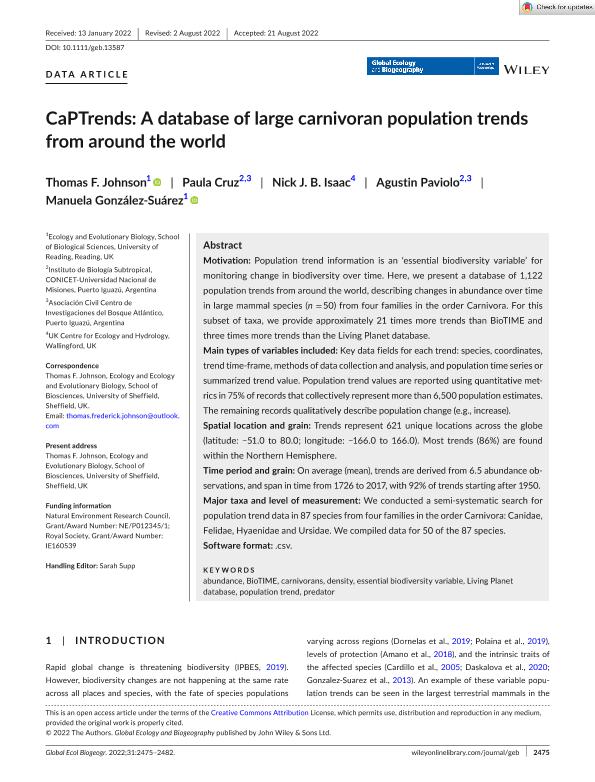Mostrar el registro sencillo del ítem
dc.contributor.author
Johnson, Thomas F.
dc.contributor.author
Cruz, María Paula

dc.contributor.author
Isaac, Nick J. B.
dc.contributor.author
Paviolo, Agustin Javier

dc.contributor.author
González Suárez, Manuela
dc.date.available
2023-06-26T13:09:10Z
dc.date.issued
2022-12
dc.identifier.citation
Johnson, Thomas F.; Cruz, María Paula; Isaac, Nick J. B.; Paviolo, Agustin Javier; González Suárez, Manuela; CaPTrends: A database of large carnivoran population trends from around the world; Wiley Blackwell Publishing, Inc; Global Ecology and Biogeography; 31; 12; 12-2022; 2475-2482
dc.identifier.issn
1466-822X
dc.identifier.uri
http://hdl.handle.net/11336/201454
dc.description.abstract
Motivation: Population trend information is an ‘essential biodiversity variable’ for monitoring change in biodiversity over time. Here, we present a database of 1,122 population trends from around the world, describing changes in abundance over time in large mammal species (n = 50) from four families in the order Carnivora. For this subset of taxa, we provide approximately 21 times more trends than BioTIME and three times more trends than the Living Planet database. Main types of variables included: Key data fields for each trend: species, coordinates, trend time-frame, methods of data collection and analysis, and population time series or summarized trend value. Population trend values are reported using quantitative metrics in 75% of records that collectively represent more than 6,500 population estimates. The remaining records qualitatively describe population change (e.g., increase). Spatial location and grain: Trends represent 621 unique locations across the globe (latitude: −51.0 to 80.0; longitude: −166.0 to 166.0). Most trends (86%) are found within the Northern Hemisphere. Time period and grain: On average (mean), trends are derived from 6.5 abundance observations, and span in time from 1726 to 2017, with 92% of trends starting after 1950. Major taxa and level of measurement: We conducted a semi-systematic search for population trend data in 87 species from four families in the order Carnivora: Canidae, Felidae, Hyaenidae and Ursidae. We compiled data for 50 of the 87 species.
dc.format
application/pdf
dc.language.iso
eng
dc.publisher
Wiley Blackwell Publishing, Inc

dc.rights
info:eu-repo/semantics/openAccess
dc.rights.uri
https://creativecommons.org/licenses/by/2.5/ar/
dc.subject
ABUNDANCE
dc.subject
BIOTIME
dc.subject
CARNIVORANS
dc.subject
DENSITY
dc.subject
ESSENTIAL BIODIVERSITY VARIABLE
dc.subject
LIVING PLANET DATABASE
dc.subject
POPULATION TREND
dc.subject
PREDATOR
dc.subject.classification
Ecología

dc.subject.classification
Ciencias Biológicas

dc.subject.classification
CIENCIAS NATURALES Y EXACTAS

dc.title
CaPTrends: A database of large carnivoran population trends from around the world
dc.type
info:eu-repo/semantics/article
dc.type
info:ar-repo/semantics/artículo
dc.type
info:eu-repo/semantics/publishedVersion
dc.date.updated
2023-06-23T16:21:29Z
dc.journal.volume
31
dc.journal.number
12
dc.journal.pagination
2475-2482
dc.journal.pais
Reino Unido

dc.journal.ciudad
Londres
dc.description.fil
Fil: Johnson, Thomas F.. University of Reading; Reino Unido
dc.description.fil
Fil: Cruz, María Paula. Consejo Nacional de Investigaciones Científicas y Técnicas. Centro Científico Tecnológico Conicet - Nordeste. Instituto de Biología Subtropical. Universidad Nacional de Misiones. Instituto de Biología Subtropical; Argentina
dc.description.fil
Fil: Isaac, Nick J. B.. No especifíca;
dc.description.fil
Fil: Paviolo, Agustin Javier. Consejo Nacional de Investigaciones Científicas y Técnicas. Centro Científico Tecnológico Conicet - Nordeste. Instituto de Biología Subtropical. Universidad Nacional de Misiones. Instituto de Biología Subtropical; Argentina
dc.description.fil
Fil: González Suárez, Manuela. University of Reading; Reino Unido
dc.journal.title
Global Ecology and Biogeography

dc.relation.alternativeid
info:eu-repo/semantics/altIdentifier/doi/http://dx.doi.org/10.1111/geb.13587
Archivos asociados
